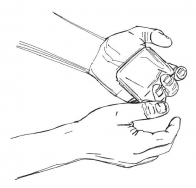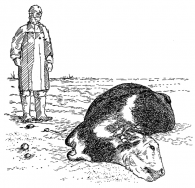41. Handling and slaughtering animals
41. Handling and slaughtering animals
Last update: 2025-06-03
Overview
- Animals can carry and spread germs that cause diseases. These include livestock animals such as such as cattle, domestic poultry birds, and pigs, companion animals such as dogs and cats, household vectors such as rats, and wild animals such as bats and wild birds.
- All animals can carry germs in their bodies when they are alive and in their meat and offals when they are slaughtered for food. Animal by-products, such as milk or eggs, can also carry germs.
- Animals that have died (including foetuses that have been aborted or animals that died during birth) can also carry germs.
- To avoid spreading diseases, it is important to wear personal protective equipment and follow recommended hygiene practices when dealing with live or dead animals and their by-products.
Diseases transmitted by animals
| Disease | Animals | Transmission |
|---|---|---|
| Rift Valley fever | Sheep, cattle. other animals. Signs and symptoms in infected animals: abortion; deaths in young. | Transmitted by mosquito bites; droplets in the air; the blood of sick animals; the bodies of infected dead animals. |
| Avian influenza | Wild and domestic poultry (birds). Signs and symptoms in infected animals: death or neurological signs; may have no signs of illness. | Transmitted through droplets in the air; feathers; and potentially the eggs and meat of infected birds. |
| Mpox | Mainly monkeys. Also rats, squirrels and prairie dogs. Signs and symptoms in infected animals: mainly none. Skin sores, breathing problems in prairie dogs. | Transmitted by touching infected animals or their body fluids; the bite or scratch of an infected animal; the meat of infected animals. |
| Plague | Mainly rats. Also rabbits, squirrels and prairie dogs. Signs and symptoms in infected animals: none in above. May cause disease in cats and occasionally dogs. | Transmitted by flea bites and domestic rats; droplets in the air; the bodies of dead infected animals. |
| Leptospirosis | Cattle, pigs, rodents (mainly rats). Signs and symptoms in infected animals: abortion; liver and kidney disease. None in rats. | Transmitted by contact (through a cut, eyes, mouth etc.); or ingestion of the urine of an infected animal. |
| MERS | Camels. Signs and symptoms in infected animals: none. | Transmitted by close contact with an infected animal or person. |
| Hantavirus pulmonary syndrome | Rodents (mainly rats). Signs and symptoms in infected animals: none. | Transmitted by droplets of rodent urine or faeces in the air; the bodies of dead infected rodents; a bite or a scratch. |
| Anthrax | Sheep, cattle (cows) and other animals. Signs and symptoms in infected animals: sudden death in sheep and cattle; neck swelling with breathing difficulties in pigs, dogs and cats. | Transmitted by contact with, or eating, infected animal products; spores in the air. |
| Rabies | Primarily dogs, but may affect other mammals such as cats, livestock and wildlife; initial signs include fever, pain and unusual or unexplained tingling, pricking, or burning sensations at the wound site, later progressive and fatal neurological signs | Dog bites and scratches cause 99% of the human rabies cases |
Handling poultry and livestock
| Poultry (birds) | Sheep and cows |
|---|---|
|
|
Handling bushmeat (monkeys, rodents, wild pigs and others)
Bushmeat should be discouraged as a food source, especially in areas where epidemic-causing infections are present in bushmeat. However, sometimes people may continue to eat bushmeat and to use bushmeat by-products. In these cases, volunteers should promote the following messages:
- Do not let children play where animal carcasses are kept.
- Cook bushmeat thoroughly.
- When preparing raw meat, always use clean utensils (knives, forks) and clean surfaces.
- After cooking, use new utensils for eating. Never use the same utensils that you cook with.
- When slaughtering, butchering or skinning bushmeat, be sure to protect yourself. Wear gloves and goggles if possible.
- If you come upon an animal in the bush that appears sick or is already dead, do not handle it without protection (for example, gloves).
- Observe animals for signs of sickness. If you detect illness, inform the authorities.
- Wash hands thoroughly with soap and water after any contact with living or dead animals.
- Dispose of animal carcasses appropriately and swiftly (by burning or burying).


